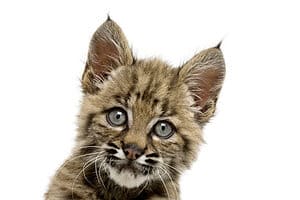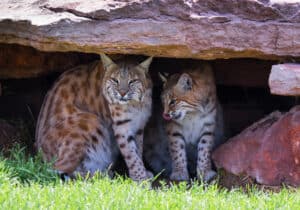There are two types of big cats in Florida the bobcat and the panther. The smaller of the two is the bobcat, so it’s really easy to tell them apart. Additionally, bobcats in Florida are more abundant than the panther, so sightings of them are more frequent. Furthermore, they have the highest population of any other wildcat species in the USA. Other names for these cats are wildcat and Florida lynx. Females have territories that cover around six square miles of rural or urban areas. However, males have a much larger territory of approximately 30 square miles. While most big cat species that occur in suburban areas are significant pests, the bobcat doesn’t cause much damage but can dig holes in and around properties.
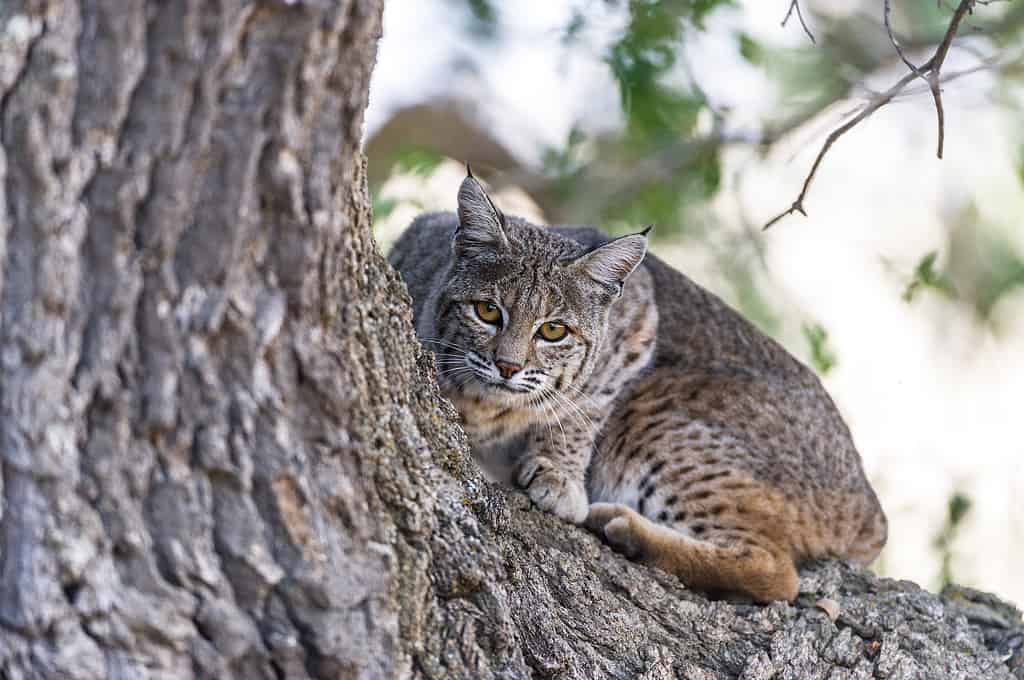
This bobcat climbed an oak tree to better view its hunting grounds.
©iStock.com/brentawp
About Bobcats in Florida
The Florida bobcat (Felida rufus Floridanus) is easily identified by its namesake, its short tail, and tufts of fur on the sides of its face. Furthermore, they typically weigh between 13 and 30 pounds, and their tails have black markings on the top and white underneath. Florida bobcats range in color from gray to reddish-brown and are covered in white spots. Adult bobcats can reach 50 inches in length and grow to 21 inches tall. In addition, their maximum weight is approximately 35 pounds. Therefore, people often mistake them for young Florida panthers because they are similar in size. The panther and bobcat can coexist in the same area because their diets differ.
The average lifespan of a Florida bobcat is approximately 14 years in the wild and 18 years in captivity. These wildcats live in dens, primarily caves, rock croppings, hollow trees, or other open shelters. However, these cats are always prepared, as they can have multiple homes; they build spare dens throughout their territory if the need for shelter arises while patrolling. These bobcats are incredibly adaptable and can survive in various habitats, including urban gardens and even the streets of cities, late at night while they are not so busy. However, they are very wary of humans unless people offer them food.
Florida bobcats don’t have any predators as they can swim and climb, making them hard to catch. However, they can fall victim to humans who hunt them or kill them for trespassing. Therefore, their population numbers in Florida are stable and not threatened or endangered. The male bobcat has a large territory, often overlapping several females’ territories, which is convenient for mating. Females have a gestation period of 50 to 60 days, and they generally have litters of one to two kittens.
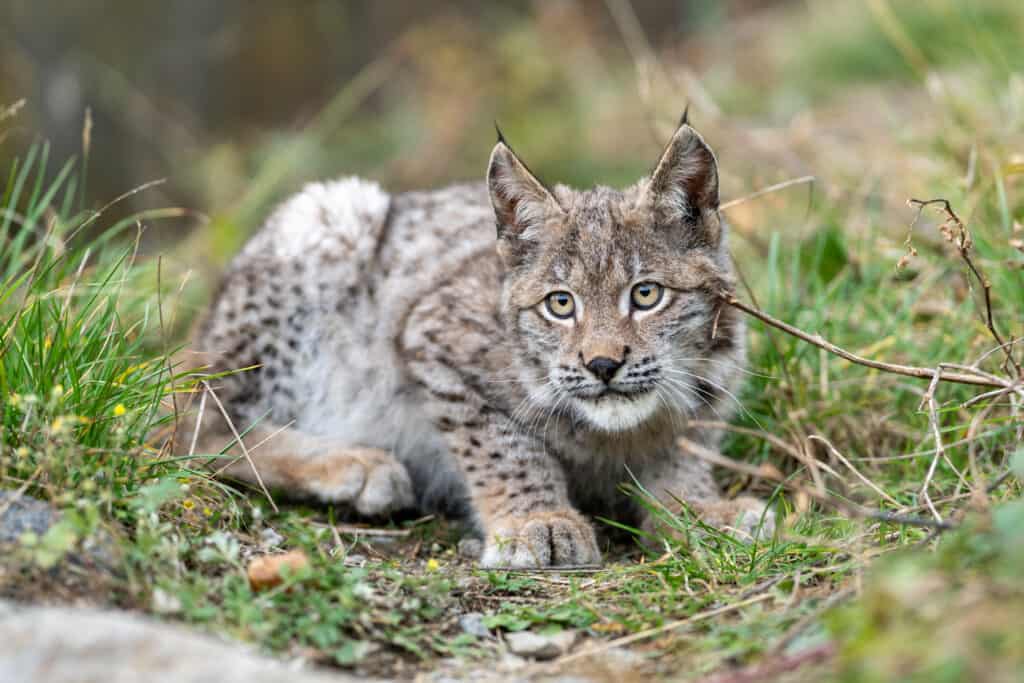
Bobcats do most of their hunting at night.
©Vaclav Sebek/Shutterstock.com
Where Do Bobcats Live in Florida?
Bobcats in Florida are solitary and very territorial. For example, same-sex bobcats will never share a home range unless it’s a mother and her kittens. However, some territories may overlap with same-sex neighbors. Furthermore, females will allow males to wander through their territories; the same goes for males with females. Their structure of living is basically the same as humans who own and occupy homes. Their habitats include swamps, forests, and hammock land. In addition, Florida’s dense shrub thickets and patches of saw palmetto provide perfect den sites.
These wild cats have territories of around 6 to 30 square miles and will patrol them slowly and carefully. Their ranges are oval-shaped, as the borders often follow streams, roads, or natural contours. Furthermore, their territory sizes do change depending on the season. For example, males tend to expand their borders to find a mate during the breeding season. Additionally, females will often patrol a smaller area when they have kittens to look after.
How Many Bobcats Are in Florida?
There was a time when bobcats occurred all over North America, from Mexico all the way to Canada. However, bobcat numbers decreased in several eastern and Midwestern states in the 1900s because they were hunted for their fur. But in the 1970s, a law was passed to protect these wildcats, increasing their population numbers. Currently, there are around 725,000 to 1,020,000 bobcats in the wild, with 300 000 in Florida alone. Therefore, they are not listed as threatened or endangered. But unfortunately, they are classified as fur-bearing game, which means people can still hunt them during certain months of the year.
Diet: What Do Bobcats Eat?

Bobcats are carnivores and skilled hunters.
©gobirdnerds/Shutterstock.com
Bobcats are not fussy eaters, meaning they have a wide variety in their diets, which includes birds, carrion, and small rodents. They are primarily nocturnal animals, but they do sometimes hunt during the day when necessary. Therefore, during Florida’s summer months, these bobcats will mainly feed on local animals like rabbits, opossums, squirrels, and raccoons. However, in winter, they focus on migrating birds that fly through the Sunshine states that are escaping the cold in the North.
What Attracts Bobcats to Your Home?
When people live in areas with a lot of larger predators, there is always a risk these stealthy hunters might prey on their pets. However, bobcats usually pose no threat to your furry friends. Research has shown that bobs do not include pets in their diets, despite living in areas where there are a lot of residential homes. Bobcats in Florida eat a lot of rodents and don’t particularly like preying on animals that can bite or claw back. Additionally, attacks on humans are incredibly rare and usually result from rabid bobcats. Furthermore, venturing into suburbia is significantly dangerous for these cats because of mange, which can occur from bobcats ingesting rodents killed by poison. But it’s not only bobcats that are affected by this issue; birds of prey and other wildlife are also at risk, so it’s best to find a safe way to deal with vermin.
Bobcat Prevention
While bobcats are typically elusive, quiet, and shy, once they invade your property, it might be tough to get rid of them, especially if they have kittens. However, there are deterrents and adjustments you can make to your home that make it less inviting to Florida bobcats and other wildlife, which include:
- Remove any excess vegetation and get rid of secluded hiding spots
- When your pets are indoors, remove their food and water from outside areas
- Install noise or motion-activated deterrents that will scare off bobcats
- If you have fruit trees, harvest them immediately and pick up any discarded fruit
- Bang pot lids together, use a motion-activated sprinkler or air horn, or have a radio outside that plays continuously
- Bobcats are drawn to gardens by squirrels, birds, or rodents, so if you have bird feeders, ensure there is no overflowing bird seed on the ground, which attracts rodents.
- Installing fencing can deter bobcats in Florida. For example, fencing six feet or higher is perfect. However, the bottom needs to extend 6 to 12 inches underground and have a 45-degree angle at the top facing outwards, 16 inches in width.
- If there are fowl or chickens on the property, they need to be put in a secure coop overnight
- Small pets like rabbits or guinea pigs should never be left unattended in a poorly-enclosed yard
Other Predators in Florida
There are several Florida predators that can cause plenty of harm to humans. Not all of these deadly pests are big. For example, there are venomous spiders and snakes that can do a lot of damage. However, the larger predators are the ones you really need to avoid, especially because they have strong jaws and sharp teeth. But there’s no need to worry because these animals usually only attack if provoked, startled, or when protecting their young. So, if you respect them, they are unlikely to cause you any harm.
Florida Black Bears
One of the largest and deadliest animals in Florida is the black bear. They inhabit wooded areas and were very common before the European settlers arrived. However, since then, their population has severely declined due to hunting. Currently, they are an endangered species, and locals barely see them anymore.
Unfortunately, most of the remaining black bears in Florida are food-conditioned and habituated, and they have lost their fear of humans. Therefore, they are primarily killed in car accidents because they wander into suburban areas. And, if they aren’t killed by being knocked over by a car, they get shot by residents protecting their properties and neighborhood.
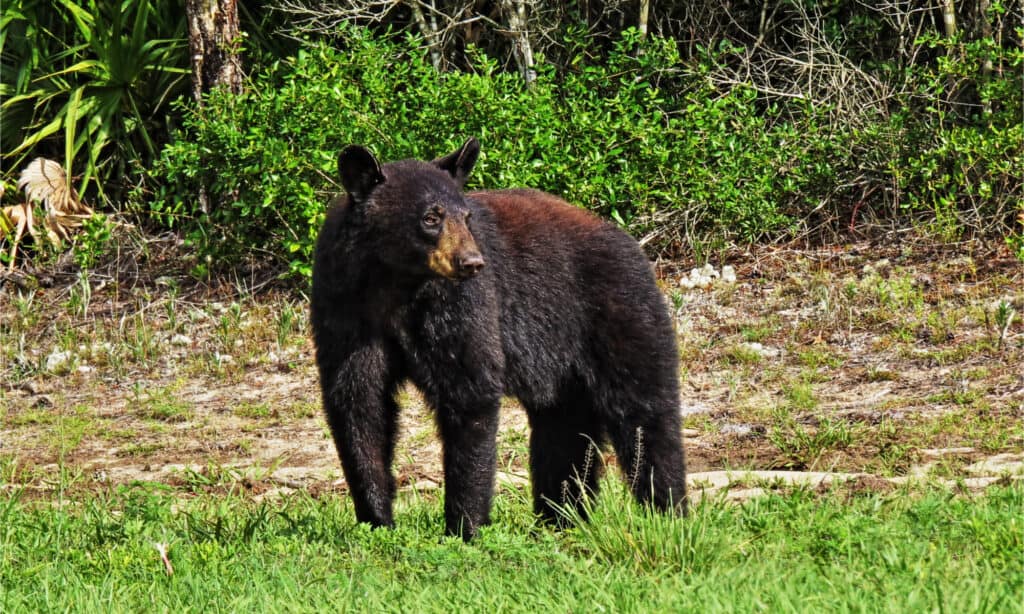
Florida black bears are very rare and hardly ever seen anymore.
©Roger Epps/Shutterstock.com
Sharks
There are several shark species that occur in Florida’s coastal waters, including:
- Sandbar sharks
- Spinner sharks
- Blacknose sharks
- Blacktip sharks
- Lemon sharks
- Sharpnose sharks
- Nurse sharks
- Bonnethead sharks
- Great white sharks
- Bull sharks
- Scalloped hammerhead sharks
Not all these shark species harm humans, but the Great White shark and bull shark can be deadly. This is because their teeth are sharp enough to shear instead of hold, and their massive size. But, even though these attacks cause major injuries, very few are deadly. In fact, since 1690, there have been 1,032 reported shark attacks in the United States, and 50 were fatal.
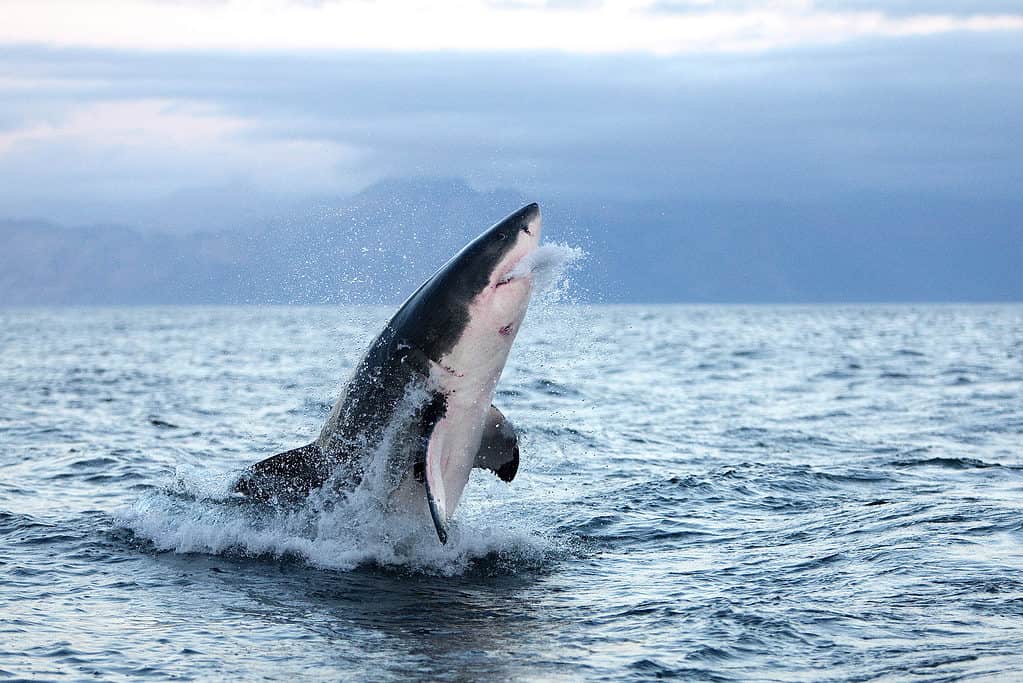
Great White sharks (as seen here) and bull sharks can be deadly.
©slowmotiongli/Shutterstock.com
American Alligators
These large, intimidating reptiles have a bite more powerful than any other animal found in Florida and should be treated with a lot of respect and caution. Many people think these alligators are vicious predators, but they typically swim away when humans come too near. However, you should never take any risks around this reptile, especially when they are trying to protect their offspring. Also, if they feel threatened, they will fight back. Sadly, sometimes they mistake small children or pets for prey.

Alligators have broad, round snouts, while the crocodile’s mouth is more pointed.
©iStock.com/Bradley Proxmire
People often confuse American alligators for crocodiles, which is believable because they look so similar. But, the best way to differentiate between the two is by their snouts. For example, alligators have broad, round snouts, while the crocodile‘s mouth is more pointed. Additionally, the latter only occurs in the southern tip of the Sunshine State, while alligators inhabit most of the southeastern United States. Finally, while crocodiles are also extremely dangerous, the American species is less aggressive than the Australian or African versions.
Bonus: Coyotes Have Invaded Florida and Are a Bigger Threat Than Bobcats
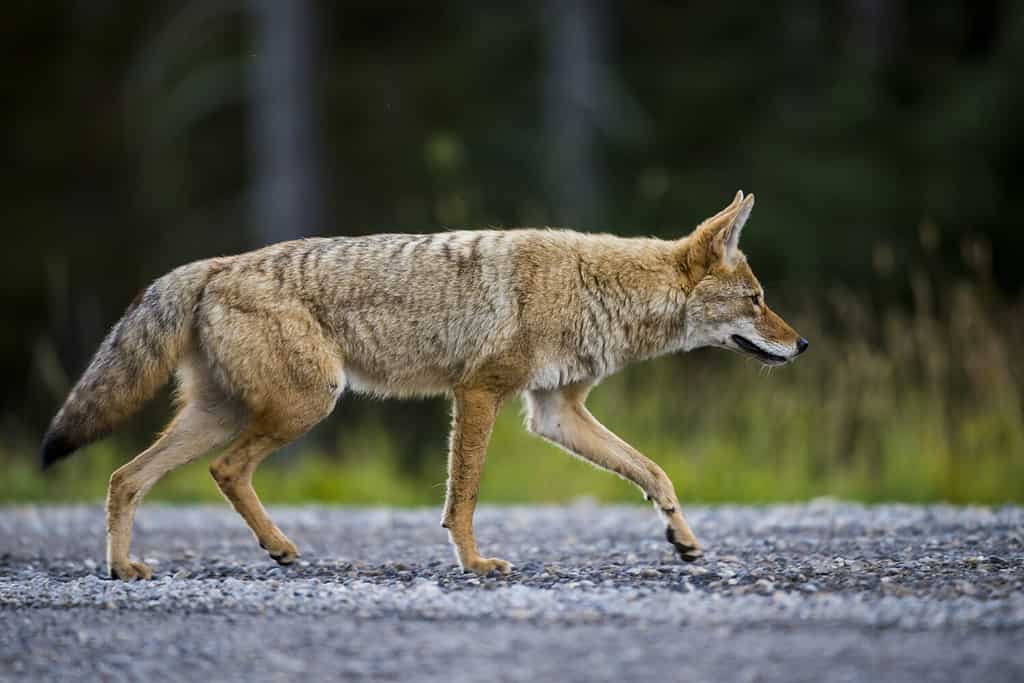
Coyotes now dwell in every county in Florida.
©BGSmith/Shutterstock.com
Not that long ago, a coyote was synonymous with the prairies and deserts of the great American West along with cowboys and wagon trains. Now, they are everywhere – in cities, neighborhoods, and land all across the United States. Coyotes thrive in urban areas because they take advantage of any little patch of habitat and they will eat anything – garbage, pet food – even pets themselves.
How have they expanded their range so quickly and thoroughly? Coyotes have been on the move since the 1800s – when European settlers transformed the native landscape through logging and agricultural development. This created more open habitats in eastern states – and the coyotes moved in as land opened up. This happened as humans attempted to exterminate wolves and cougars, which decreased competition for coyotes. They took advantage of every opportunity.
Coyotes are highly adaptable and seem to like golf courses and parks. They aren’t picky about where they sleep at night – often just sleeping out in the open or under a shrub in someone’s yard. Experts have no idea how many coyotes there are – estimates range from one to 10 million in North America. There are just too many to count with their number increasing.
The photo featured at the top of this post is © iStock.com/Anita Elder Design
FAQs (Frequently Asked Questions)
What to do if you see a bobcat in Florida?
Firstly, pick up any small pet or child, and then start talking or whistling to let the bobcat know you are there. If it starts to approach, scream, stomp your feet, or clap your hands to scare it off.
How big is a Florida bobcat?
Bobcats typically weigh between 13 and 30 pounds, and their tails have black markings on the top and white underneath. Florida bobcats range in color from gray to reddish-brown and are covered in white spots. Adult bobcats can reach 50 inches in length and grow to 21 inches tall. In addition, their maximum weight is approximately 35 pounds.
Are bobcats aggressive?
Attacks on humans are incredibly rare and usually only result from rabid bobcats.
Thank you for reading! Have some feedback for us? Contact the AZ Animals editorial team.



